News
National Skin Cancer Awareness Week 2021
November 19, 2021
Skin cancer is still Australia’s most common cancer. It is also the most costly and one of the most preventable. Every year, two in three Australians will be diagnosed with skin cancer by the age of 70, About 2,000 Australians die from skin cancer each year.
Risk Factors
There are many risk factors that increase the chances of melanoma, including:
- fair skin
- high mole count
- family history
- pattern of sunburns throughout life, especially during childhood.
Prevention
In order to reduce the risk of developing skin cancer, all Australians need to use the five forms of sun protection when the UV level is 3 or higher:
- Slip on sun protective clothing that covers as much skin as possible.
- Slop on broad spectrum, water resistant SPF30 (or higher) sunscreen. Apply 20 minutes before going outdoors and every two hours afterwards.
- Slap on a hat – broad brim or legionnaire style to protect your face, head, neck and ears.
- Seek shade.
- Slide on sunglasses – make sure they meet Australian Standards.
Self-Checks
Try to become familiar with the look of your skin, so you can pick up any changes that might suggest a skin cancer. Look for:
- any crusty, non-healing sores
- small lumps that are red, pale or pearly in colour
- new spots, freckles or any moles changing in colour, thickness or shape over a period of weeks to months.
If you notice a strange new mole on your skin or an old mole that’s started changing, it’s important to see your GP right away. Some people at higher risk require regular, planned skin assessments.
Diagnosis and Treatment
Your GP will conduct a skin check using a magnifying instrument called a dermoscope. If they find anything concerning, they may recommend cryotherapy or other non-surgical treatments, or biopsy or referral to a dermatologist. If you require surgical treatment, you will need to make a subsequent appointment.
For more informatiuon, visit the Cancer Council.

